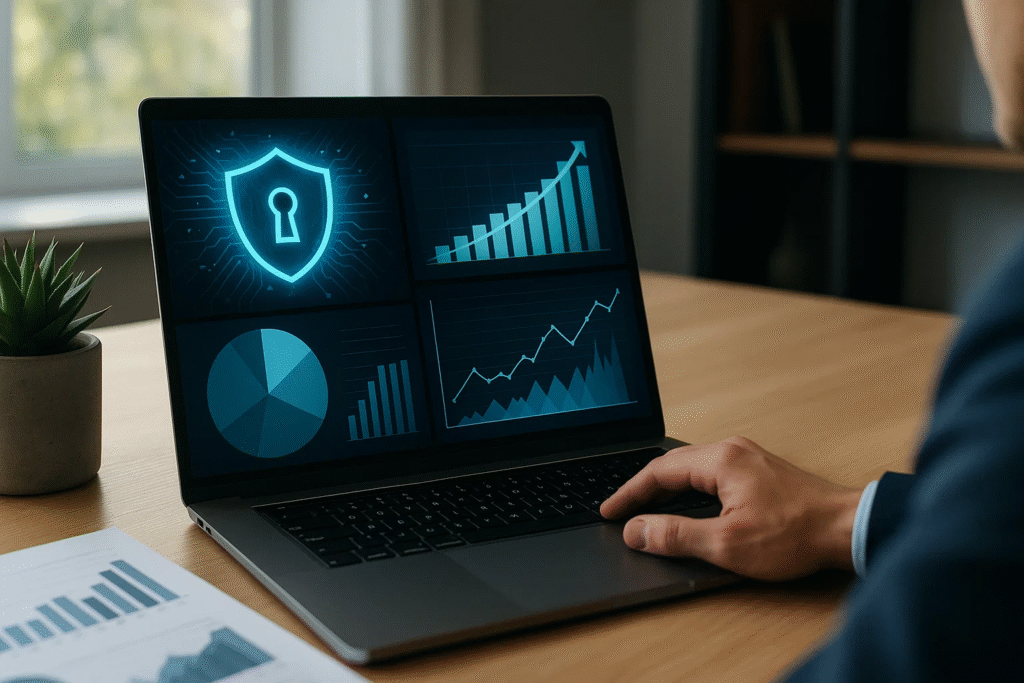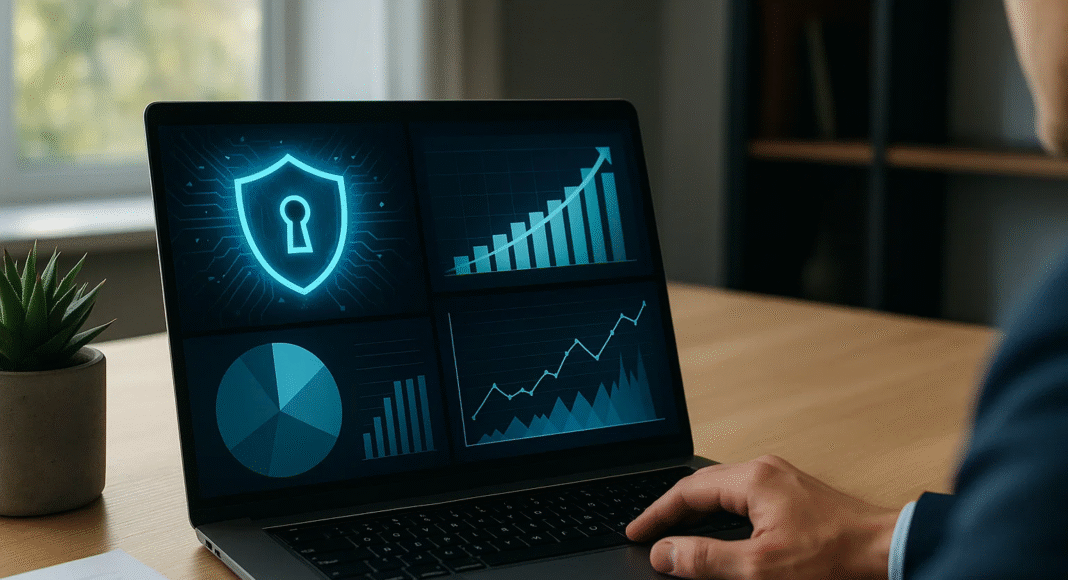Key Takeaways
- Global cybersecurity spending in 2026 continues to surge as businesses adopt AI-driven and automated computer security solutions.
- Zero-trust architectures, predictive analytics, and real-time threat detection are redefining modern cybersecurity strategies.
- Data privacy compliance, user education, and advanced encryption are becoming essential for safeguarding digital assets worldwide.
In 2026, the landscape of computer security continues to evolve at an unprecedented pace, driven by the rapid digital transformation of businesses, the proliferation of artificial intelligence, and the growing sophistication of cyber threats. As organizations across industries increasingly rely on cloud-based systems, automation tools, and interconnected networks, the importance of robust computer security software has never been greater. Cybersecurity is no longer a secondary consideration—it is a fundamental component of every digital infrastructure. From small startups to global enterprises, the demand for comprehensive protection against data breaches, ransomware, phishing, and insider threats continues to surge.
Also, read our top guide on the Top 10 Best Computer Security Software in 2025.

The global computer security software market in 2026 reflects this urgency, with spending projected to surpass trillions of dollars as companies strengthen their defense mechanisms. This surge in investment is not only influenced by the increasing number of cyberattacks but also by stricter regulatory frameworks and compliance requirements that compel organizations to implement advanced data protection measures. Sectors such as finance, healthcare, government, and e-commerce have become primary targets for cybercriminals, making the need for next-generation security tools—powered by artificial intelligence (AI), machine learning (ML), and behavioral analytics—an absolute necessity.
Moreover, as remote and hybrid work models remain dominant, cybersecurity strategies are being redefined to protect dispersed networks and digital workspaces. Cloud security, endpoint protection, identity management, and zero-trust architectures are becoming standard in ensuring data integrity and user safety. These changes have led to a new generation of security solutions that go beyond traditional antivirus software—encompassing predictive threat detection, automated incident response, and real-time monitoring systems capable of countering complex attacks before they occur.
The latest computer security software statistics, data, and trends for 2026 provide a clear view of how the industry is transforming in response to new digital realities. From the rise in global ransomware incidents to the increasing adoption of AI-driven cybersecurity tools, these insights reveal where businesses are prioritizing their security investments and how innovation is reshaping the fight against cybercrime. For instance, the use of AI in cybersecurity has drastically improved threat detection accuracy and reduced response times, while blockchain technology is emerging as a critical tool for ensuring data integrity and secure transactions.
Additionally, user awareness and training have become integral components of cybersecurity strategies. Human error continues to be one of the leading causes of data breaches, pushing organizations to invest in employee education and phishing simulation programs. At the same time, the cybersecurity talent gap remains a persistent challenge, with global demand for skilled professionals far exceeding supply. This shortage has further accelerated the adoption of automated and AI-powered systems to fill the operational void.
Understanding the top computer security software statistics and trends in 2026 is vital for business leaders, IT professionals, and policymakers aiming to stay ahead of evolving cyber risks. The insights derived from these data points not only highlight the growing complexity of digital threats but also underscore the rapid technological advancements shaping modern security infrastructures. Whether it is the increase in global cybersecurity spending, the evolution of encryption standards, or the rising integration of AI-driven predictive defense systems, each trend reflects a broader shift toward a more resilient and proactive cybersecurity ecosystem.
This comprehensive overview of the top 25 computer security software statistics, data, and trends in 2026 will provide readers with valuable knowledge about how the cybersecurity industry is adapting to new challenges and opportunities. It will explore how technological innovation, regulatory shifts, and changing user behaviors are influencing the global security landscape, ultimately helping businesses make informed decisions in safeguarding their digital assets. In a world where data is the new currency and cyber threats are more pervasive than ever, understanding these emerging trends is essential for anyone seeking to navigate the digital age securely and confidently.
Before we venture further into this article, we would like to share who we are and what we do.
About 9cv9
9cv9 is a business tech startup based in Singapore and Asia, with a strong presence all over the world.
With over nine years of startup and business experience, and being highly involved in connecting with thousands of companies and startups, the 9cv9 team has listed some important learning points in this overview of the Top 25 Computer Security Software Statistics, Data & Trends in 2026.
If your company needs recruitment and headhunting services to hire top-quality employees, you can use 9cv9 headhunting and recruitment services to hire top talents and candidates. Find out more here, or send over an email to [email protected].
Or just post 1 free job posting here at 9cv9 Hiring Portal in under 10 minutes.
Top 25 Computer Security Software Statistics, Data & Trends in 2026
- The global cybersecurity software market was estimated to be worth approximately 210 billion U.S. dollars in 2024 and is projected to escalate to around 500 billion dollars by 2033, representing a compound annual growth rate (CAGR) of 12.5% during the years 2026 to 2033, indicating substantial market expansion potential.
- The enterprise security software segment is forecasted to grow significantly from an estimated value of 80 billion dollars in 2024 to approximately 132 billion dollars in 2028, underlining increasing demand within business sectors.
- The consumer cybersecurity software market reached a valuation of 7.8 billion dollars in 2022, with future projections suggesting growth to more than 20 billion dollars by 2032, reflecting a steady CAGR of about 10.1% driven by heightened awareness and adoption among individual users.
- The overall security software market was valued at roughly 65.25 billion dollars in 2025, with forecasts pointing toward 108.96 billion dollars in 2030, signifying robust growth fueled by rising cybersecurity needs.
- In 2025, the global cybersecurity software market was valued at about 141 billion dollars, confirming its substantial economic footprint and increasing relevance in digital security strategies worldwide.
- In the United States, around 66% of adult internet users—which translates to approximately 169 million people—reported using antivirus software to protect their digital assets as of 2025, highlighting widespread personal cybersecurity measures.
- Among these antivirus users in the U.S., 61% rely on free software options, whereas 36% prefer paid subscriptions for enhanced protection, indicating diverse consumer preferences and accessibility levels.
- Approximately 10 million adult internet users in the U.S., representing 11% of those not currently using antivirus software, expressed an intention to adopt antivirus solutions within the next six months, reflecting potential market growth.
- In the United Kingdom, 66% of cybersecurity software vendors primarily target clients in the technology sector, 31% serve finance industry customers, and 25% focus on healthcare providers, demonstrating sector-specific demand concentrations.
- The most common barriers cited by those not using antivirus software include perceived high costs, noted by 45% of non-users, and concerns about data privacy, reported by 57%, showing challenges in increasing adoption rates.
- Only one-quarter (25%) of antivirus software users consider their protection software to be very effective, underscoring ongoing issues with consumer trust and software performance perceptions.
- Despite a rising frequency of cyber threats, antivirus software adoption rates in the U.S. remained flat in 2025, suggesting stagnant growth in a crucial security market segment.
- Cybercrime caused financial losses totaling 16.6 billion dollars in the U.S. during 2024, up by 33% compared to the prior year, illustrating the growing economic impact of digital threats.
- About 82% of breaches involving cloud infrastructure compromise data specifically associated with cloud computing environments, indicating a significant vulnerability domain.
- The average cost incurred from a cloud data breach globally has been calculated at approximately 4.45 million dollars, emphasizing the high stakes of cybersecurity failures in cloud environments.
- Human error is responsible for roughly 82% of cloud misconfiguration incidents, highlighting one of the leading causes of susceptibility in cloud security.
- Organizations in the United Kingdom that have adopted unified identity management strategies witnessed a 47% reduction in identity-related security incidents and experienced a 62% improvement in the speed of their incident response, demonstrating the effectiveness of integrated security approaches.
- Among U.S. antivirus users, 63% believe their browsing habits to be a more effective protective measure against cyber threats than antivirus software itself, reflecting behavioral perceptions about personal cybersecurity.
- Cyber-attacks in Russia increased by 15% during the year 2024, suggesting an elevated threat environment in that region.
- The share of imported software in Russia’s public sector dropped from 70% in 2020 to 40% in 2024, demonstrating a significant shift toward domestic alternatives in government IT procurement, likely driven by security and policy considerations.
- Among cybersecurity software providers, client distribution is as follows: 66% serve technology sector clients, 31% serve financial services, 25% healthcare, 23% government, 16% retail, 14% education, and 8% each for telecommunications and automotive industries, indicating diverse market penetration.
- Secondary markets such as manufacturing, energy, construction, and media sectors each contribute between 3% and 9% to the client base of cybersecurity software providers, reflecting broader industry adoption.
- The leading antivirus software programs in 2025 are Microsoft Defender, McAfee, and Norton, which dominate in consumer popularity and market presence.
- Employment in the cybersecurity field is expected to grow by 35% from 2021 to 2031 according to U.S. Bureau of Labor Statistics, indicating strong labor market demand in cybersecurity professions.
- Key global companies in cybersecurity software include McAfee, IBM, Microsoft, Check Point, Sophos, Cisco, Juniper Networks, AVG Technologies, Fortinet, and CyberArk, representing the market’s competitive landscape.
Conclusion
As 2026 unfolds, it is evident that computer security software continues to serve as the cornerstone of digital resilience in an increasingly interconnected world. The top 25 statistics, data, and trends discussed throughout this analysis reveal that the global cybersecurity landscape is not only growing in complexity but also evolving toward a more proactive, intelligent, and adaptive future. From AI-powered threat detection and predictive analytics to the rise of zero-trust frameworks and quantum-resistant encryption, the innovations shaping computer security today are redefining how organizations protect their digital ecosystems against both existing and emerging threats.
One of the most significant takeaways from the 2026 cybersecurity trends is the undeniable rise in global spending and adoption of advanced security tools across all sectors. Enterprises, governments, and even small and medium-sized businesses are recognizing that cybersecurity is no longer a technical afterthought—it is a business imperative. The exponential increase in ransomware attacks, phishing scams, and insider threats has made the implementation of robust security frameworks a top strategic priority. The move toward automation, AI integration, and continuous monitoring underscores the industry’s shift from reactive defense mechanisms to intelligent, data-driven prevention systems that identify vulnerabilities before they can be exploited.
Another defining feature of 2026’s computer security landscape is the growing emphasis on data privacy and regulatory compliance. As global data protection regulations become stricter—such as the GDPR, CCPA, and new regional privacy laws—organizations must ensure that their security software aligns with compliance mandates. Failure to do so not only risks financial penalties but also damages brand trust. Consequently, compliance-driven security solutions and governance tools have become essential components of modern cybersecurity infrastructure, ensuring transparency, accountability, and secure data management practices.
The integration of artificial intelligence and machine learning within cybersecurity software has also proven transformative. These technologies have drastically enhanced the speed and accuracy of threat detection while minimizing false positives and enabling real-time responses. By learning from past incidents and continuously adapting to new attack patterns, AI-driven systems have given businesses a critical advantage in anticipating and countering cyber threats. Furthermore, the incorporation of automation has alleviated the burden on overextended IT teams, addressing the ongoing cybersecurity talent shortage that continues to challenge organizations worldwide.
However, the 2026 trends also highlight an important truth: technology alone is not enough to safeguard digital environments. Human factors remain one of the most vulnerable points in cybersecurity frameworks. Phishing attacks, social engineering, and weak password practices continue to expose organizations to significant risks. As a result, employee education and awareness training have become indispensable elements of modern cybersecurity strategies. Building a culture of security mindfulness ensures that individuals at every level of an organization understand their role in preventing breaches and maintaining data integrity.
Looking ahead, the future of computer security will be shaped by the convergence of several key developments: the rise of decentralized security models, greater use of blockchain for data verification, quantum computing challenges, and the continuous evolution of threat intelligence networks. Organizations that proactively invest in adaptive, AI-driven security technologies and prioritize both compliance and user education will be best positioned to navigate this dynamic environment.
In summary, the data and trends from 2026 highlight a cybersecurity industry in rapid transformation—driven by innovation, necessity, and an ever-changing threat landscape. The demand for integrated, scalable, and intelligent computer security solutions will only intensify as digital infrastructures expand and cybercriminal tactics evolve. For businesses, policymakers, and individuals alike, understanding these statistics and insights is critical for building strong defense systems, ensuring compliance, and maintaining trust in a digital-first economy.
The year 2026 marks not just another chapter in the evolution of cybersecurity but a pivotal turning point toward a smarter, more resilient future. By leveraging advanced technologies, fostering cyber awareness, and embracing proactive security strategies, organizations can not only defend against today’s complex threats but also shape a safer and more secure digital tomorrow.
If you find this article useful, why not share it with your hiring manager and C-level suite friends and also leave a nice comment below?
We, at the 9cv9 Research Team, strive to bring the latest and most meaningful data, guides, and statistics to your doorstep.
To get access to top-quality guides, click over to 9cv9 Blog.
To hire top talents using our modern AI-powered recruitment agency, find out more at 9cv9 Modern AI-Powered Recruitment Agency.
People Also Ask
What are the key computer security software trends in 2026?
In 2026, major trends include AI-driven threat detection, zero-trust frameworks, cloud-based protection, and advanced data encryption technologies.
Why is computer security software important in 2026?
With rising cyberattacks and data breaches, computer security software is essential for protecting networks, sensitive data, and digital infrastructure.
How has AI impacted cybersecurity in 2026?
AI enhances cybersecurity by automating threat detection, predicting attacks, and improving incident response times across organizations.
What industries benefit most from computer security software in 2026?
Industries like finance, healthcare, government, and e-commerce benefit most due to high data sensitivity and frequent cyber threats.
What is the global cybersecurity market size in 2026?
The global cybersecurity market is projected to exceed $300 billion in 2026, driven by increased digital transformation and rising cyber risks.
What are the top cybersecurity threats in 2026?
Common threats include ransomware, phishing, insider attacks, data breaches, and AI-powered cyber exploits targeting cloud systems.
How does zero-trust security work in 2026?
Zero-trust frameworks eliminate implicit trust by continuously verifying every user and device before granting access to systems.
What role does machine learning play in cybersecurity in 2026?
Machine learning identifies unusual patterns, detects threats faster, and strengthens predictive analysis in modern cybersecurity systems.
Are cloud security solutions popular in 2026?
Yes, as remote work grows, cloud security solutions are in high demand to safeguard data and applications hosted on cloud platforms.
How does automation improve computer security in 2026?
Automation helps detect and respond to threats faster, reduce human error, and enhance efficiency in cybersecurity operations.
What are the major cybersecurity compliance standards in 2026?
Key standards include GDPR, CCPA, ISO 27001, and region-specific privacy regulations focusing on data protection and risk management.
How are companies addressing ransomware attacks in 2026?
Companies are using advanced backup systems, AI-driven monitoring, and zero-trust security frameworks to prevent and recover from attacks.
Why is data encryption essential in 2026?
Data encryption protects sensitive information from unauthorized access, ensuring privacy and compliance with global data regulations.
What are the latest developments in endpoint security in 2026?
Endpoint security integrates behavioral analytics, AI detection, and automated patch management to protect devices from complex threats.
How are small businesses improving cybersecurity in 2026?
Small businesses are adopting affordable cloud-based security software and managed cybersecurity services to enhance protection.
What impact does the cybersecurity talent shortage have in 2026?
The shortage pushes companies to adopt automation, AI tools, and outsourced cybersecurity solutions to manage growing cyber risks.
How is remote work affecting cybersecurity in 2026?
Remote work increases vulnerabilities, prompting businesses to invest in VPNs, multi-factor authentication, and cloud security systems.
What is predictive cybersecurity in 2026?
Predictive cybersecurity uses AI and analytics to forecast potential threats before they occur, improving proactive defense strategies.
Which regions lead in cybersecurity adoption in 2026?
North America, Europe, and Asia-Pacific lead in cybersecurity adoption, driven by regulations, digital innovation, and cyber threat levels.
What is the role of blockchain in cybersecurity in 2026?
Blockchain enhances data integrity and transaction security by providing decentralized, tamper-proof systems for digital protection.
How are phishing attacks evolving in 2026?
Phishing attacks are becoming more sophisticated, using AI-generated content and personalized messages to deceive users effectively.
Why is cybersecurity training vital in 2026?
Employee awareness training helps reduce human error, prevent phishing incidents, and strengthen the overall security posture of organizations.
What are the top cybersecurity investment priorities in 2026?
Businesses prioritize AI security tools, cloud protection, zero-trust models, and real-time monitoring for stronger digital defense.
How are governments supporting cybersecurity in 2026?
Governments enforce stricter regulations, invest in cybersecurity research, and collaborate with private sectors to combat cybercrime.
What is the future of antivirus software in 2026?
Traditional antivirus tools are evolving into AI-based endpoint protection systems capable of detecting advanced, real-time threats.
How does user authentication improve in 2026?
Multi-factor and biometric authentication systems enhance identity verification, reducing the risk of unauthorized system access.
What are the key cybersecurity technologies in 2026?
Key technologies include AI, ML, blockchain, behavioral analytics, and automated threat response systems for proactive protection.
How is cybersecurity affecting digital transformation in 2026?
Cybersecurity enables safer digital transformation by protecting new technologies and ensuring trust in data-driven innovations.
What can businesses do to prepare for future cyber threats beyond 2026?
Businesses should adopt adaptive AI tools, invest in cybersecurity training, and establish a zero-trust infrastructure to stay protected.
What are the long-term cybersecurity trends beyond 2026?
Long-term trends include quantum-proof encryption, autonomous threat response, and deeper integration of AI in global cybersecurity systems.
Sources
- Cyber Security Software Market Report 2025 (Global Edition)
- Security software – statistics & facts (Statista)
- Consumer Cybersecurity Software Market Size | Forecast
- Security Software Market Size, Scope, Forecast
- Global Cybersecurity Market | 2019 – 2030
- 2025 Antivirus Trends, Statistics, and Market Report
- AI and software cyber security market analysis (UK Government)
- Threats and Vulnerabilities in Cloud Computing: A Comprehensive Security Analysis
- Economic security and digitalization: challenges and Russia’s path to sustainable development
- The Human-Machine Identity Blur: A Unified Framework for Cybersecurity Risk Management in 2025
- Cybersecurity for Industry 5.0: trends and gaps
- At the Cybersecurity Frontier: Key Strategies and Persistent Challenges for Business Leaders
- A global analysis of data breaches from 2004 to 2024
- TechRank: A Network-Centrality Approach for Informed Cybersecurity-Investment
- Cybersecurity Market Size, Share, Analysis | Global Report …
- Cybersecurity Statistics 2025: Rising Threats and Industry Outlook































![Writing A Good CV [6 Tips To Improve Your CV] 6 Tips To Improve Your CV](https://blog.9cv9.com/wp-content/uploads/2020/06/2020-06-02-2-100x70.png)


